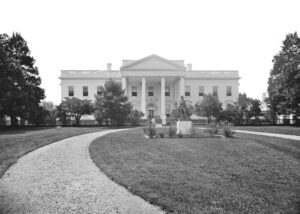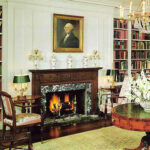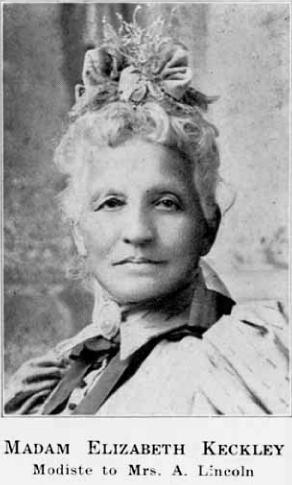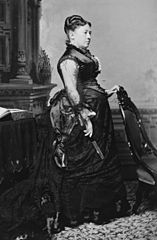
During the course of the nineteenth century, First Ladies emerged from behind their husband’s careers to become separate personalities. Though these women were still identified most broadly as wives and mothers, social expectations changed. This second installment in my series about First Ladies profiles a selection of nineteenth century First Ladies who caught my interest: political wives, a teacher, an army wife, and a young presidential niece.
Sarah Polk, aka, Sahara Sarah

In many ways, Sarah Childress Polk reflects early nineteenth century social reform, particularly the Temperance Movement. Without children to take up her time, Sarah devoted herself to her husband’s political career.
Beginning in 1826, when James Polk began his Congressional career, until the end of his presidency, Sarah engaged in social interactions with her husband’s colleagues, handled all his incoming and outgoing correspondence, coordinated his speaking engagements and press coverage, and advised him on his speeches.

Sarah was a devout Presbyterian. No business of any kind took place on a Sunday. In her role of First Lady, Sarah banned dancing, card games, and hard liquor. Sarah’s entertainments were so sober, she was sometimes called Sahara Sarah. However, guests present at dinner parties were served the appropriate wine for each course. A congressman’s wife, described a four-hour dinner party with forty guests. At each place setting, glassware held wines ranging from pink champagne to ruby port, essentially forming “a rainbow around each plate.“
Like her husband, Sarah suppored slavery and manifest destiny.
Abigail Fillmore ~The First Teacher in the White House

In 1819 Abigail Powers Fillmore accepted a teaching position at the New Hope Academy in upstate New York. She was 21 years old. Her oldest student, Millard Fillmore, was nineteen. A shared love of learning brought teacher and student closer together. In 1826 after a long courtship, the couple married. Abigail continued her teaching career until the first of her two children was born in 1828, the same year her husband launched his political career and joined the New York Assembly. In 1849 when her husband became vice-president under Zachary Taylor, Abigail probably thought this would be his highest office. But in July 1850, the president died.
When the official mourning period was over, Abigail received visitors on Tuesday mornings, held public receptions on Friday nights, organized formal dinners on Thursdays, and smaller dinners on Saturdays. Receptions were particularly difficult for Abigail, because after she broke her ankle in 1842, she could not comfortably stand for hours greeting guests.

Abigail gained a reputation for her support of the White House library, though the story may be apocyrphal. She did preside over a literary salon to which she invited visiting writers.
Abigail was the first presidential spouse known for her with a former teaching career and ongoing interest in education. She was also the first presidential spouse to have her full-length portrait reproduced on paper cards, called carte de visites, that were widely sold in 1853.
Harriet Lane: Presidential Niece
James Buchanan was a life-long bachelor, the only president who never married. After his younger sister and her husband died, Buchanan assumed the role of guardian to Harriet and her older sister. Over the years, Harriet became her uncle’s political partner.

In 1854 during the Pierce Administration, Buchanan was the American Ambassador to Great Britain. At age 24, Harriet joined her uncle in London where she became a favorite of Queen Victoria, who gave her the protocol status equal to a spousal ministerial consort.
Buchanan became president in 1857 with Harriet as his hostess.
During a time of increasing sectional strife, Harriet had the delicate task of working out seating arrangements for her weekly formal dinner parties. Harriet had to seat guests appropriately for their status, while keeping political enemies apart. Otherwise, both verbal and physical disagreements could break out. Harriet’s task became increasingly difficult as sectional frictions increased. By the time Buchanan left office, seven states had seceded from the Union.
Other social duties were more enjoyable. In 1860 Edward, Prince of Wales, visited America, and became the first member of a European royal family to stay at the White House.
Harriet pushed social boundaries when she and Edward played a game of kingpins, a type of lawn bowling. The event caused a stir because women weren’t supposed to display any physical abilities, especially in company with a man.
“Miss Todd, I want to dance with you in the worst way.” – Attributed to A. Lincoln.

According to Todd family tradition, Mary met Abraham Lincoln at a ball when he asked her to dance. Mary came from a wealthy, slave-holding political family based in Kentucky. She was highly educated for a woman and very interested in politics. One of her suitors was Stephen Douglas, the Senator from Illinois. The man she married became president in 1861. The couple had four sons. Eddie died in 1850 from tuberculosis. Willie died of typhoid while the family lived at the White House. The illustration above depicts the youngest son Tad who died in 1871, and oldest son Robert, who lived until 1926.
In 1860 Abraham Lincoln won enough electoral votes to become president, despite the fact that he wasn’t on the ballot in any of the southern states. Shots were fired at Ft. Sumpter, and the nation broke apart.
When the Lincoln family moved to Washington, Mary had no connections or mentors. Many criticized Mary’s coarse manners and said she was pretentious. She definately had her moments.
For example, Congress appropriated $20,000 to redecorate the public and private White House rooms, including the purchase of new china. Mary overspent by $6000. Congress passed two separate appropriation bills to cover the cost.
Mary thought decorating and entertainment expenses were justified in order to create a respectable image as the legitimate government of the United States. Mary’s critics saw a vain and selfish woman, an image not improved by her extravagant fashion purchases.

Mary Lincoln 
Elizabeth Keckley 
Keckley Design for Lincoln
And yet, even these had a purpose. Mary’s fashion consultant was Elizabeth Keckley, a woman who purchased her freedom in 1855, moved Washington and established a dressmaking business that employed 20 seamstresses. Mary met Elizabeth the day of Lincoln’s inauguration. The two women became friends, and Elizabeth guided Mary to a more sophisticated style of clothing than the lace and flowers Mary previously wore.
Julia Grant: Army Wife

While a student at West Point, Hiram Ulysses Grant became friends with Fred Dent, who introduced Grant to his family, particularly his sister Julia. The couple married in 1848 and raised a family of three sons and a daughter. Unwilling to continue the family separations of army life, Grant resigned his commission and held a number of jobs before being named a general in the Union army.
On the campaign trail, Grant missed his wife, so Julia left her children with relatives and joined Grant during his campaigns in Memphis, Vicksburg, Nashville, and Virgina. Sometimes the children traveled with her.
Julia thought her husband had a duty to serve as president and threw herself into his 1868 presidential campaign. When delegations came to their home in Galena, Illinois, she welcomed them and served refreshments. After his inauguration, Ulysses turned to his wife and asked, “And now, my dear, I hope you’re satisfied?” Presumably, she was.

Dressed in a gown of white satin accessorized with diamonds and pearls at her first Inaugural Ball, Julia represented a new type of first lady, one who would be a figure of public interest. Dolley Madison, the last First Lady to serve eight years, created a formal platform for the presidency. Julia brought Americans into the White House family by sharing images of her family life.
When the Grants moved into the White House, Congress appropriated $25,000 for the first family’s renovations. Julia used the funds on the family rooms in the western end of the second floor, and the executive offices in the eastern wing.
When the Grants entered their second term, Congress appropriated $100,000 to update the public rooms on the first floor. Julia brought in a decorating firm from New York, and work was completed in 1874.

In May of that year, daughter Nellie became the first White House bride. The wedding took place in the newly redecorated East Room. The French chandeliers had thousands of glass pieces attached to a nickel-plated framework with multiple shaded glass globes for gaslights.
During the course of the nineteenth century, First Ladies became women with families and professional aspirations, as well as representing their office. As the twentieth century approached, their sphere continued to expand.
* ~ *
Illustrations
Sarah Childress Polk by George Dury after an 1846 portrait by George Peter Alexander Healy.
Abigail Powers Fillmore. Photograph.
White House Library.
Harriet Lane. 1860 Photograph.
Lincoln Family 1867. Currier and Ives Lithograph.
Mary Todd Lincoln. Photo by Matthew Brady.
Elizabeth Keckley. Unknown Date.
Dress for Mary Lincoln designed by Elizabeth Keckley, 1861.
Julia Grant. Photo by Matthew Brady, between 1875 and 1880.
Julia Grant with her father and her children son Jessie, daughter, Nellie. Between 1865 & 1880. by Mathew Brady.
East Room as designed by Stephane Boudin during the Kennedy Administration.
National First Ladies’ Library.
National Museum of American History: First Ladies
First Ladies of the United States. National Portrait Gallery.

Sandra Wagner-Wright holds the doctoral degree in history and taught women’s and global history at the University of Hawai`i. Sandra travels for her research, most recently to Salem, Massachusetts, the setting of her new Salem Stories series. She also enjoys traveling for new experiences. Recent trips include Antarctica and a river cruise on the Rhine from Amsterdam to Basel.
Sandra particularly likes writing about strong women who make a difference. She lives in Hilo, Hawai`i with her family and writes a blog relating to history, travel, and the idiosyncrasies of life.

